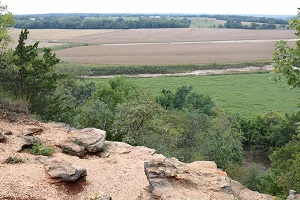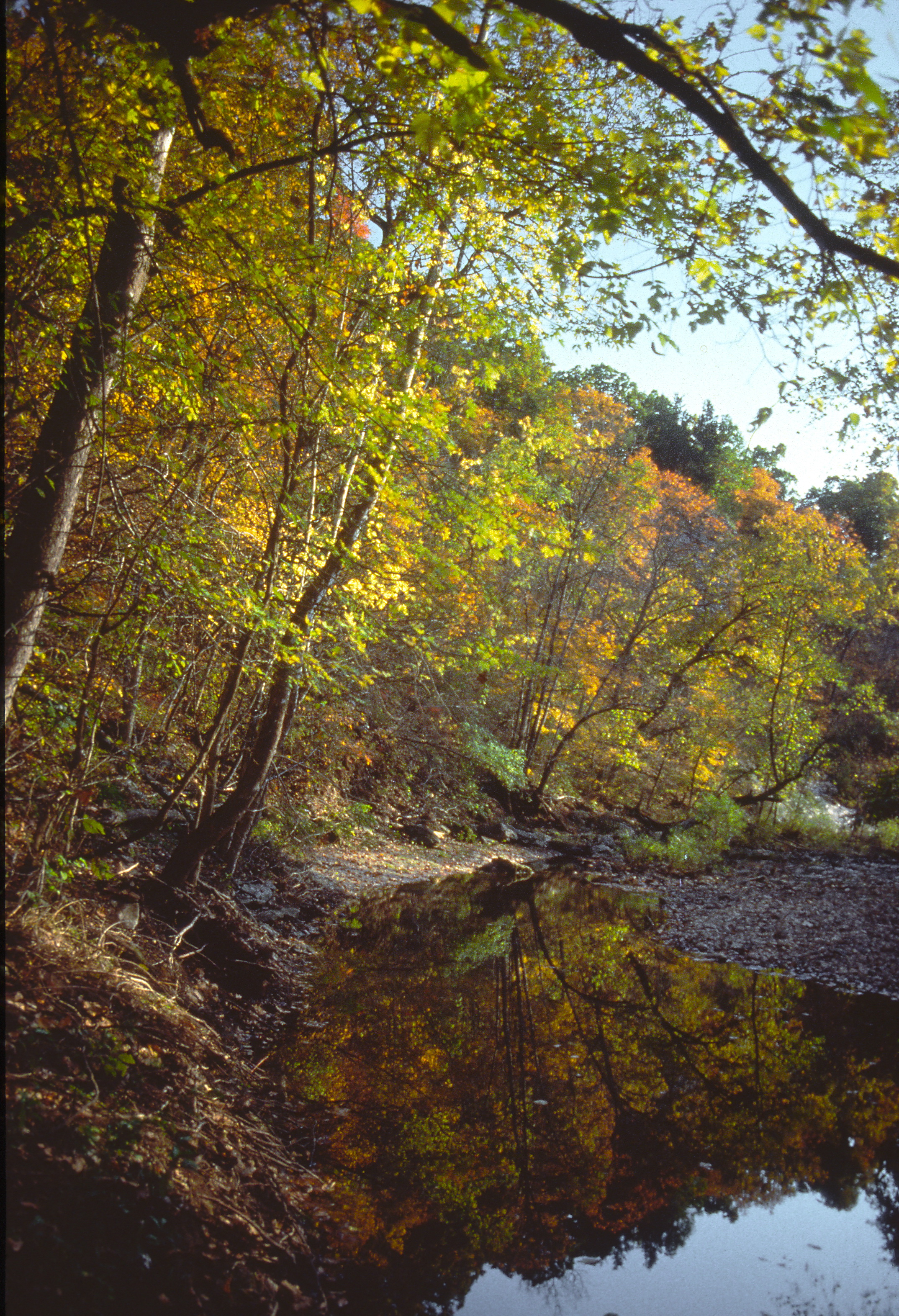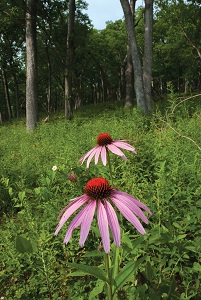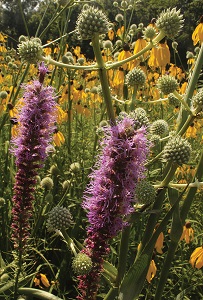at Cuivre River State Park
 Cuivre River State Park is located in a unique region northwest of St. Louis called the Lincoln Hills. The Lincoln Hills were once covered by glaciers and glacial erratics (glacial-carried boulders and rocks) are scattered throughout the park. Woodland, prairie and savanna communities grow on soils formed from this glacial till. Despite its location in northeast Missouri, in many ways the Lincoln Hills resemble the Ozarks of southern Missouri. Limestone bedrock is exposed in bluffs, glades and woodlands and has dissolved to form karst topography with sinkholes, caves and springs. These habitats provide a home for many characteristic Ozark plants and animals.
Cuivre River State Park is located in a unique region northwest of St. Louis called the Lincoln Hills. The Lincoln Hills were once covered by glaciers and glacial erratics (glacial-carried boulders and rocks) are scattered throughout the park. Woodland, prairie and savanna communities grow on soils formed from this glacial till. Despite its location in northeast Missouri, in many ways the Lincoln Hills resemble the Ozarks of southern Missouri. Limestone bedrock is exposed in bluffs, glades and woodlands and has dissolved to form karst topography with sinkholes, caves and springs. These habitats provide a home for many characteristic Ozark plants and animals.
 Cuivre River borders the southwest boundary of the park below Frenchman’s Bluff for about a mile. However, Big Sugar Creek, a tributary of Cuivre River, is the stream that shaped and defines the park. Big Sugar Creek is a scenic, gravel-bottom stream that resembles streams of the Ozark border. While much of the creek is intermittent, there are some sizable springs that feed into it part of the year. Bluffs along the creek and fish like the banded sculpin add to the Ozark similarities.
Cuivre River borders the southwest boundary of the park below Frenchman’s Bluff for about a mile. However, Big Sugar Creek, a tributary of Cuivre River, is the stream that shaped and defines the park. Big Sugar Creek is a scenic, gravel-bottom stream that resembles streams of the Ozark border. While much of the creek is intermittent, there are some sizable springs that feed into it part of the year. Bluffs along the creek and fish like the banded sculpin add to the Ozark similarities.
The stream valley with extensive woodlands and scattered glades, prairie, savanna, bluffs, caves and sinkhole ponds support a great variety of plants and animals. Thousands of species are known in Cuivre River State Park, and many of them are of conservation concern. Rare species, like the cerulean warbler, ringed salamander, false yellow mallow, eastern blazing star and running buffalo clover, depend on the variety of natural habitats found here. Many of these species rely on natural communities like prairie, savanna, limestone glades and oak woodlands, which depend on fire. In order to maintain and protect these habitats and the species that depend on them, staff use prescribed burns. Driving or hiking through the park, you may notice the areas that were burned recently, and occasionally you might encounter a road or trail briefly closed because of a burn in progress. There are also ongoing control efforts to prevent invasive and exotic plants like garlic mustard and bush honeysuckle from degrading the natural resources of the park.
The great biodiversity, the number of rare and unique species, the natural communities, and the availability of them for you to experience makes Cuivre River one of the state’s most natural resource-rich parks. Nowhere else in northeast Missouri or the St. Louis region can you find such a large example of the natural landscape of oak woodlands, savanna and prairie that was encountered by the early Euro-American settlers.
Natural Areas
 The Missouri Natural Area System identifies and protects the highest quality remaining examples of the state’s natural plant and animal communities. Three natural areas covering 1,968 acres have been designated in Cuivre River State Park.
The Missouri Natural Area System identifies and protects the highest quality remaining examples of the state’s natural plant and animal communities. Three natural areas covering 1,968 acres have been designated in Cuivre River State Park.
Big Sugar Creek Natural Area
Big Sugar Creek Natural Area is a corridor along 2.3 miles of the creek in the north end of the park. Lone Spring, along Lone Spring Trail, is included in the natural area.
George A. Hamilton Forest Natural Area
A wooded valley just north of the visitor center is George A. Hamilton Forest Natural Area. This 40-acre natural area borders the east side of the park road and contributes to the scenic drive as you head north from the visitor center.
Lincoln Hills Natural Area
Lincoln Hills Natural Area encompasses 1,872 acres of the park. Woodlands, interspersed with glades, prairies, savanna, sinkholes and bluffs and bisected by Big Sugar Creek, define this superlative example of the region’s natural landscape. Portions of the natural area can be experienced along Big Sugar Creek, Cuivre River’s north loop, Prairie and Blazing Star trails.
 Wild Areas
Wild Areas
Wild areas in Missouri state parks are large undeveloped areas managed as wilderness for solitude and primitive recreation. Two separate wild areas are found within Cuivre River State Park.
Northwoods Wild Area
Northwoods Wild Area is on the north side of Highway KK at the northern end of the park. The 1,102 acres of the wild area are primarily covered by mature oak woodland. Big Sugar Creek flows through this wild area and the Big Sugar Creek Natural Area is within the wild area. Three miles of Lone Spring Trail (with a backpack campsite) provide scenic access to the Northwoods Wild Area.
Big Sugar Creek Wild Area
In the middle of the park, 1,675 acres have been designated Big Sugar Creek Wild Area. Several bluffs line Big Sugar Creek and you can catch scenic views of the creek and creek valley from Big Sugar Creek Trail and Cuivre River Trail’s north loop (both of which have a backpack campsite in the wild area). Other parts of these trails, and the Cuivre River and Turkey Hollow trails, traverse the extensive oak woodlands of the wild area. Elsewhere in the rugged terrain of the wild area are limestone glades and sinkhole ponds, which provide habitat for many unique plants and animals. A large spring, which flows about half the year, can be seen along Cuivre River Trail’s north loop.






